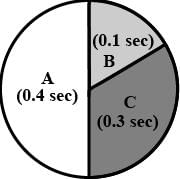Test: Cardiac Cycle (NCERT) - NEET MCQ
15 Questions MCQ Test - Test: Cardiac Cycle (NCERT)
Consider the following statements each with one or two blanks.
(i) Left auriculoventricular aperture is guarded by (1) valve while right auriculoventricular aperture is guarded by (2) valve.
(ii) In man left auricle receives (3) blood by (4) pulmonary veins.
(iii) (5) ions play a significant role in clotting.
Which one of the following options, gives the correct fill-ups for the respective blank numbers from (1) to (5) in the statements?
Which of the following statement(s) regarding the cardiac system is/are correct?
(i) Human heart is an ectodermal derivative.
(ii) Mitral valve guards the opening between the right atrium and left ventricle.
(iii) SAN is located on the left upper corner of the right atrium.
(iv) Stroke x Heart rate = Cardiac output.
The problem of electrical discontinuity caused in the normal heart by the connective tissue separating the atria from the ventricles is solved by?
'X' is the rhythmic contraction and relaxation in the aorta and its main arteries. What is X?
The figure given below three stages in the cardiac cycle

A red blood cell, entering the right side of the heart passes by or through the following structures.
1. Atrioventricular valves
2. Semilunar valves
3. Right atrium
4. Right ventricle
5. SAN
Which of the following options represents the correct sequence?
In the given figure the durations of the events of the cardiac cycle are given. Identify these events and select the correct option.

What happens when the pacemaker becomes nonfunctional?
What is the average cardiac output in a healthy individual?



















